How To Repair A Crochet Blanket In The Middle Of A Work
by Jean Leinhauser
In one case you've learned the basic crochet stitches, you lot'll want to start your kickoff pattern. (If you demand help with learning basic crochet stitches, visit www.LearnToCrochet.com.) There are hundreds of beautiful designs available for you to make, just for a beginner, they may look scary because they are written in what looks almost like a foreign language.
That's because crochet patterns are written using many abbreviations and terms, which save space and make patterns easier to read. So the get-go thing you need to do is become familiar with the abbreviations and terms.
Some of them are easy to understand, like these that represent basic stitches:
| Basic Stitch Abbreviations | |
|---|---|
| Ch | Chain |
| Sl st | slip stitch |
| Sc | single crochet |
| Hdc | half double crochet |
| Dc | double crochet |
| Tr (or trc) | triple (or treble) crochet |
Impress these out and mount them on a card to continue handy while yous work.
| Terms represent things yous are to do, similar these: | |
|---|---|
| Inc | increase (Add one or more stitches.) |
| Dec | decrease (Eliminate ane or more stitches.) |
| Turn | Turn your work then you tin can work dorsum for the next row. |
| Join | Join 2 stitches together; usually done by working a slip run up in the top of the adjacent stitch. |
| Rep | repeat (Do it over again.) |
| A complete list of crochet abbreviations and terms and their meaning can be found at: www.YarnStandards.com. | |
Getting Started
With the abbreviations terms at mitt, let'southward wait at a typical design. A pattern may be worked in rows (that is, back and forth to course a flat piece such as an afghan) or in rounds (worked around to form a tube with no seams, such every bit a hat).
Whatever mode the design is to exist worked, the very first thing you must do is make a slip knot on your hook. Does the design tell you lot this? No — it but assumes you know that!
Here is how to make a sideslip knot (See Figure i & two). So with the slip knot now on your hook, you will make a foundation concatenation of a specified length, which the blueprint volition state. The number of bondage you need may exist stated before the first row, or in the offset row, depending on the pattern writer. Here are two examples:
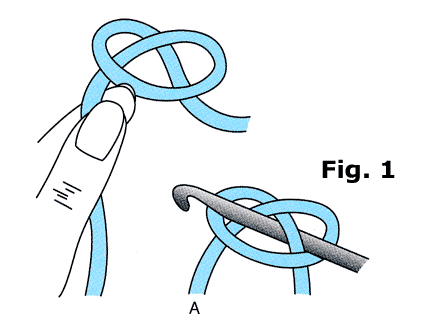
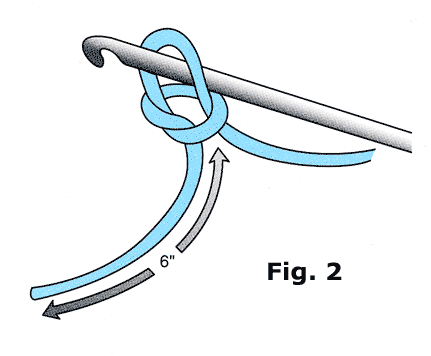
Row 1: Ch 15; sc in 2nd ch from hook and in each ch across.
or
Ch 15.
Row one: Sc in 2d ch from claw and in each ch across.
These both mean the same matter: Make a skid knot on your hook (retrieve that the patterns never tell you to practice that), and so make 15 concatenation stitches and be sure to make them loosely. Count these chains very carefully, and do not count the sideslip knot as a run up. The loop on the hook is never counted equally a stitch. (Run across Figure iii)
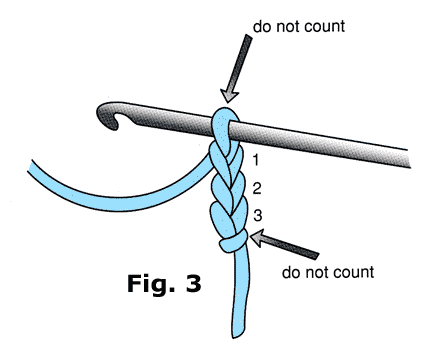
Now you take 15 chains and the blueprint says to "sc in 2d ch from hook and in each
ch across". That means that you look at your chain, count the offset chain away from the hook, which you will skip, then work a unmarried crochet in the 2nd chain away from the hook.
Why do y'all need to skip the first concatenation? Well, try to piece of work a unmarried crochet in information technology and you'll observe out! Now work the unmarried crochet in the 2d ch from the hook, and in each of the remaining (abbreviated rem) 13 chains. Yous have now completed Row 1. Count your stitches carefully, but exercise not count the loop (abbreviated lp) on the hook, or the slip knot, which is now at the end of the row. You should accept fourteen single crochet stitches.
Hint: Count the stitches at the cease of every row. Most patterns tell you how many stitches you should have, and there are several ways of doing this.
: 14 sc.
(xiv sc).
—xiv sc.
These are all ways to prove the number of stitches yous should take. Don't confuse this with an pedagogy to do something.
Remember that first chain you skipped at the start of the row? When working in single crochet, you never work in that chain. It is gone forever!
Now you accept worked Row i. Await at your design: at the end of the row it may say ch 1, turn." That means information technology is time to turn the piece of work then you can make some other row of stitches. Yous need to work the chain 1 to get your yarn high enough to begin the side by side row. Here is how to plough the work: (see Figure four). We bear witness turning the work to the right, only you tin turn information technology to the left if you prefer. Simply be sure to turn information technology the same fashion each time you turn.
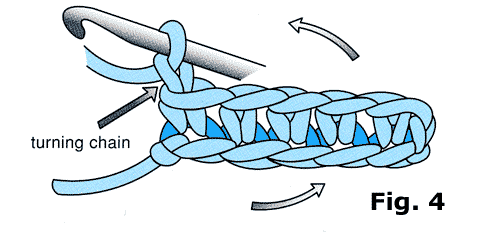
Hint: Always leave the claw in your work as you plow.
Now you lot are set to kickoff Row 2.
Simply some patterns don't tell you lot to ch 1, plow, at the end of the row. They put that in the instructions for the next row,
Then the pattern could be written in two different ways:
Row i: Sc in 2nd ch from claw and in each rem ch; ch 1, turn.
Row two: Sc in each sc across.
or
Row one: Sc in 2nd ch from hook and in each rem ch.
Row two: Ch i, turn; sc in each sc across.
It actually doesn't thing whether you work the ch 1, turn, at the end of the offset row, or at the offset of the next row. Just practice it the way the pattern tells you to.
When working Row 3 and all following rows in unmarried crochet, never count the turning ch-1 as a stitch. Information technology simply disappears, similar the skipped stitch when you worked the foundation chain.
Render to elevation
Working in Double Crochet
Skipped chains and turning chains don't disappear when working in double crochet or taller stitches. Now they count as a run up.
Let's practice a beginning row in double crochet.
The pattern says: Ch 17.
Row 1: Dc in 4th ch from hook and in chain across: 15 dc.
And then you will brand a slip knot on the hook, then make 17 chain stitches.
Now count 4 chains away from the hook, and work a double crochet into that chain, skipping the first three chains. Then work a double crochet in each of the remaining 13 chains. You at present have fifteen double crochet stitches.
How can that exist when yous accept merely worked 14 double crochets? Remember those first 3 chains you skipped when you worked the first double crochet into the 4th chain from the hook? Those iii skipped bondage count as get-go double crochet of the row, and on following rows you will work into the top chain of those iii chains just as though they were a regular dc stitch.
At the finish of this row, or the beginning of the adjacent, the pattern volition tell you how many chain stitches you lot demand to raise the yarn to the height of the stitches for the adjacent row. For single crochet, that was ane ch, and that chain did not count as a run up.
Merely for double crochet, a taller stitch, yous need to make three chains and then plough.And this time the 3 chains count every bit a stitch. So on the side by side row, you assume that the concatenation 3 counts as the start dc, and you will piece of work into the adjacent sew, not the first run up (See Figure v ).
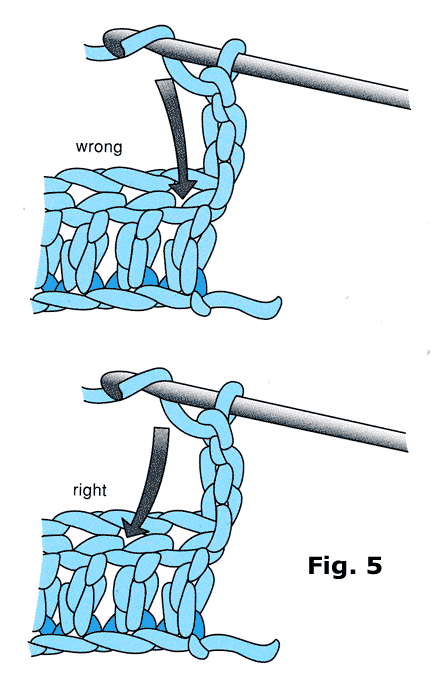
Unless your blueprint tells y'all otherwise, on all stitches taller than a single crochet, the turning chain is counted equally the offset stitch of the row.
Return to top
Parentheses, Asterisks, and Brackets
In addition to using lots of abbreviations and terms, crochet patterns use several symbols to tell you what to do. Crochet patterns often have a serial of steps that are repeated several times across a row. Rather than writing these out time subsequently time, asterisks (*) are used to signal the repeats. A pattern might read like this:
Row 3: Dc in next 3 sts; *ch 1, skip side by side st, dc in next st; rep from * beyond row (or to terminate).
That ways that the steps following the asterisk are to be repeated, in club, until you reach the terminate of the row.
Or the pattern might say:
Row 3: Dc in adjacent 3 sts; *ch i, skip adjacent st, dc in next st*, rep from * to * across row (or echo between *'s).
That is merely another style of saying the aforementioned thing, and you piece of work the steps given between the 2 asterisks, in order, across the row.
Now just to make things more complicated — sometimes yous will repeat steps several times within a row, and so cease up doing something else! That can mean you volition observe ** within the *.
Such a pattern might read:
Row iii: Dc in side by side 3 sts; *ch 1, skip next st, dc in next st,** piece of work a shell in adjacent st; rep from * beyond row, ending final rep at **.
Don't throw up your easily in horror! Take it one footstep at a fourth dimension. First, ignore that ** until the pattern tells you to practise something with it. So you will outset work the steps following the asterisk beyond the row, and the last time you will end at the **, significant you will not work the crush the concluding time.
Brackets [ ] also are used to tell you how many times to work a sure step. The number immediately following the brackets tells you how many times to do the step.
For instance:
Row 7: Dc in next 4 dc, ch 1, [sk adjacent dc, shell in next dc] 4 times, ch 1, dc in next 4 dc.
That means you volition work the [sk next dc, shell in next dc] four times earlier going on to work the ch 1, dc in next 4 dc.
Parentheses are sometimes used in the same way.
Parentheses are used to indicate a group of stitches that are to be worked together into a run up, such as: in next dc work (2 dc, ch iii, 2 dc). That means you volition work all of those stitches in one dc, which makes a vanquish.
Render to top
Working in Spaces
One teaching that oft confuses beginners is " work a trounce in next ch sp".
A concatenation infinite occurs when yous piece of work a concatenation run up, then skip a stitch, and then work into the side by side run up. The space underneath the chain, where you skipped a run up, is where you will work the beat. Spaces tin exist i or more than chains, and if they are
3 or more, are ofttimes called loops (lps).
Working in the Round
Many crochet projects include working in rounds – such as a granny square.
Instructions may read: Ch 8, bring together with a slip stitch to form a ring.
To do this, yous will make a slip knot on the claw as usual, then make 8 chs, and so insert the hook into the showtime chain fabricated, hook the yarn and depict it through the beginning chain and through the loop on the hook (See Figure six). Now y'all have a modest circle or ring into which you lot will work stitches. To start, you will need to heighten the yarn to the correct superlative with bondage, just as you would to start a row. Figure 7 shows working a double crochet stitch into the ring. Your design will tell yous what to work into the band.
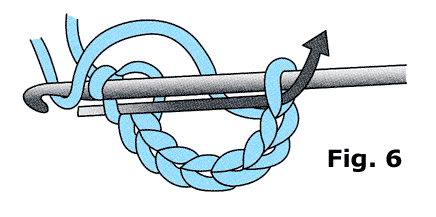
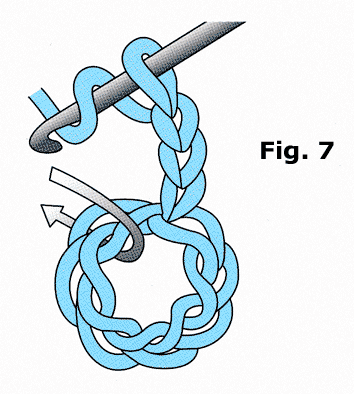
Front end or Back Loop
Well-nigh crochet stitches are worked under both loops of a sew together. Sometimes a pattern volition tell you to work in the front loop only, or into the back loop only. The forepart loop is the loop closest to you, the back loop is the loop farthest away from you (Meet Figure 8).
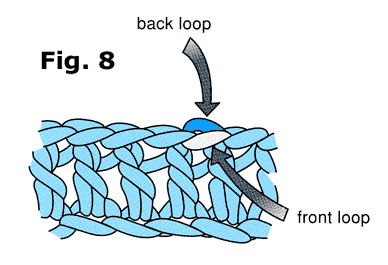
Working Garments
If yous are making a garment, you demand to know some special terms.
Correct front, right sleeve, correct shoulder: These all refer to the actual body function on which the piece will exist worn – the right arm, etc. The same applies to left front, left sleeve,left shoulder.
Correct side, wrong side: You lot may be told to work with the right (or wrong) side of the piece facing you. The right side of a garment is the side that will be seen when it is worn.
Right-manus or Left-hand Corner: You may be asked to join yarn in a specific corner. This means the corner of the piece nearest your right (or your left) manus.
At the same time: This is used when yous are asked to piece of work two unlike steps (possibly shaping at the armhole and at the neck) at the same time.
Work same as Left (or Right) piece, reversing shaping: This tin be difficult for a beginner. Allow'southward say you lot have worked a series of decreases on a left shoulder. Instead of telling you exactly how to do this for the correct shoulder, the pattern may just tell you to: Work same equally left shoulder, reversing shaping. That ways you have to figure out what to exercise! Information technology will exist easier if yous take pen and paper and sketch out what you did the first time; so do this in reverse for the other slice.
Special Thanks
Thanks to Jean Leinhauser, one of the industry's foremost designers/editors and best-selling author who has worked tirelessly to promote the arts and crafts of crochet, for preparing this helpful outline on "How to Read a Crochet Pattern."
And special thanks to Leisure Arts for granting permission to reproduce the diagrams used in this article. The diagrams are taken from Acquire to Crochet the Easy Way by Jean Leinhauser.
Return to top
Source: https://www.craftyarncouncil.com/standards/how-to-read-crochet-pattern
Posted by: herreranorigh.blogspot.com


0 Response to "How To Repair A Crochet Blanket In The Middle Of A Work"
Post a Comment